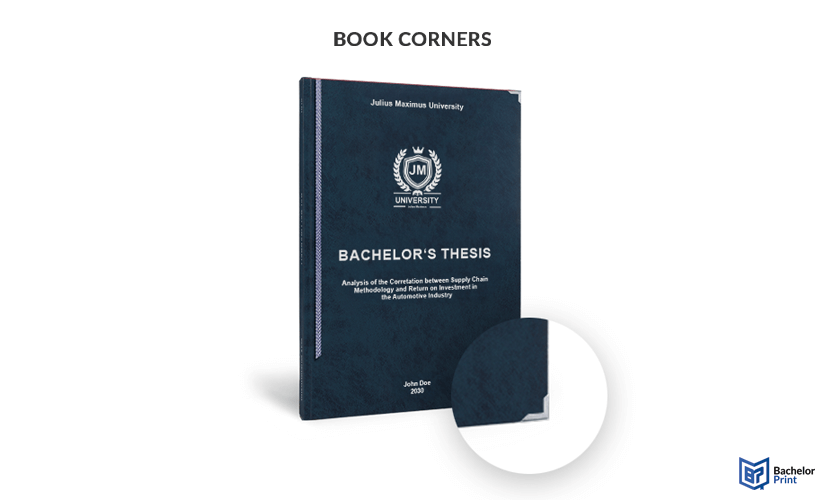
Bookbinding is the age-old craft of assembling written pages into a cohesive volume. Among its many intricate elements, book corners play an important yet often overlooked role in both preserving and enhancing a book’s durability and aesthetic. These small fittings, found on the outer corners of hardcovers and paperbacks, protect against wear. In this article, we’ll dive into the styles and purposes of book corners.
Inhaltsverzeichnis
Definition: Book corners
From ornate metal embellishments to subtle minimalist designs, book corners (or edge protectors) reflect the personality of a book just as much as its contents do. They are protective and decorative elements placed on the outer corners of a book cover, typically on hardbound or softcover books, and tightened by squeezing them with pliers. However, these protective corners don’t only work on books but also on pocket calendars, notebooks, folders, and menus.

Hardcover with individual embossing
- Price calculator & 3D live preview
- Professional binding for thesis, dissertation, or books
- Print on demand with fast delivery right to your doorstep
Learn more!
Purpose
Book corners have two purposes: being functional and aesthetically pleasing.
Functional
In terms of functionality, book corners reinforce the edges of the book covers, which are especially vulnerable to damage from handling, shelving, and transport. They help extend the lifespan of the book by shielding the corners from bending and fraying, which is especially recommended for professional thesis printing and binding.
Aesthetic
Many students, casual readers, and book enthusiasts know that books with dog-ears don’t look as pretty as the ones without. That’s why book corners exist: to enhance the book’s overall appearance. Book corners can range from simple metal fittings to ornate, engraved designs that beautifully complement antique or custom bindings.
Materials
Book corners are typically made from materials that are designed to withstand frequent handling. The most common materials are:
- Metal for a sturdy feel
- Leather for handmade journals
- Brass & nickel for a classic look
- Stainless steel for a modern appearance
- Cardstock painted with metallic acrylic paint (DIY)
- Aluminum for budget-friendly or minimalistic designs
Paperback with your individual design
- Individual design for thesis, dissertation, or books
- Order online with fast delivery right to your doorstep
- Use a customizable pre-made design or create your own
Learn more!
DIY
When binding your books, you don’t have to rely solely on shop-bought book corners. With a little creativity and a few tools, you can craft custom corners that are both functional and visually unique. Below are some DIY suggestions, along with the bookbinding tools you’ll need for each method.
Fabric book corners can also be used as bookmarks, and they add a soft touch to your books. You can embroider them with initials, patterns, or decorative motifs to personalize your project. Here’s a helpful online guide.
Special tools you need:
- Sewing awl
- Embroidery needle
- Embroidery scissors
Tape is one of the simplest and most accessible materials for making book corners. Depending on your choice — mending tape, washi tape, or patterned masking tape — you can go for protective, colorful, or even artistic results. Here’s an online guide.
Special tools you need:
- Ruler
- Scissors or a craft knife
You can also make origami-style book corners made of paper. You can use patterned or coloured paper to match your book’s theme. Here’s a helpful guide. If you’d like, you can even create a mix of paper and tape book corners or even paint your paper with metallic acrylic paint to add a special touch.
Special tools you need:
- Ruler
- Folding bone
- Paper trimmer
Note: Use a thicker paper like cardstock or origami paper for durability.
FAQs
A book corner protector is a decorative element placed on the outer corners of a book cover. It helps prevent wear on hardcover and paperback books.
To protect your book corners, you can purchase or DIY book corner protectors and place them on the corners of your hardcover or paperback.
You simply need to slide them over the cover’s corners and gently press or clamp them into place. For DIY corners made of paper or fabric, they’re typically glued or sewn into position.
Corner protectors can be made from a variety of materials, including:
- Metal
- Paper
- Fabric
- Faux leather